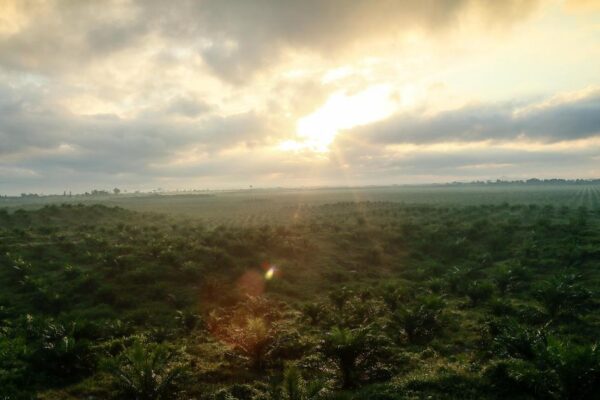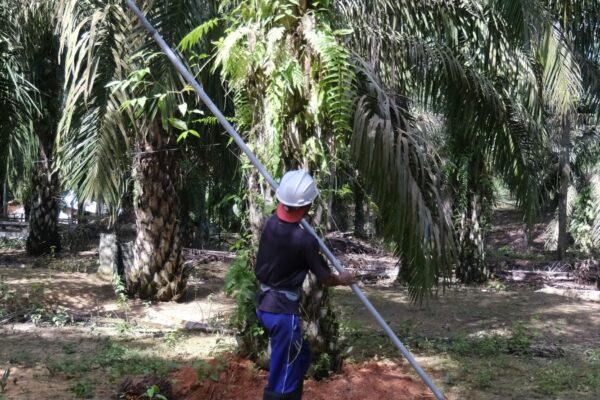This multimedia piece is part of Earthworm Foundation's awareness campaign on the importance of forests and healthy forest landscapes. Visit our #ForTheForests campaign page and follow #ForTheForests across social media channels to learn more.
How palm ended up playing a big role in Malaysia
The oil palm – indigenous to West Africa – was first brought to Malaysia in 1870s as an ornamental plant. It soon became common along roads, government buildings and parks.
In Europe, the Industrial Revolution brought many entrepreneurs to the East, one of which was Frenchman Henri Fauconnier. In 1917, Fauconnier set up the first commercial oil palm estate in Batang Berjuntai, Selangor – in what was then the British colony of Malaya.
Since gaining independence in 1957, agriculture – rubber and palm oil in particular – has been a major part of the Malaysian government’s efforts to develop the nation and its rural poor.
Today, Malaysia is the world’s second largest producer of palm oil, producing 19.1 million tonnes – and exporting 17.7 million tonnes of this – in 2020.
Palm oil makes up the largest part of Malaysia’s agricultural sector, which contributed about $25 billion to the country’s GPD (Gross Domestic Product) in 2019. Oil palm plantations cover about 18 percent of land in Malaysia; directly employing 441,000 people, over half of whom are small growers.
While oil palm produces six to ten times more oil per hectare compared to rapeseed, soybean, olive and sunflower, development from this wonder crop has come at a cost.
Forest loss and the reasons behind it
According to the Global Forest Watch, Malaysia lost 2.7 million hectares of primary forest between 2002 and 2020, which is a 17 percent decrease. This was primarily due to the rapid development of roads, towns and infrastructure, as well as agriculture.
This development was built on an economic boom in the 80s and 90s, largely driven by rubber, tin and timber. Malaysia is now a middle-income country. These industries have been replaced by semiconductors, electrical goods and solar panels, as well as palm and rubber products, which the country is a leading producer of.
During this time, palm oil has come under the spotlight for its links to deforestation and the exploitation of people. Both the public and private sectors have responded, to varying degrees.
Almost 30 per cent of palm oil produced in Malaysia comes from the states of Johor and Pahang. These two states also hold close to 40 per cent of Malaysia’s permanent forest reserves.
In 2021, Earthworm initiated the Southern Central Forest Spine (SCFS) landscape programme, a 1.6-million-hectare track of land running across Johor and Pahang. The landscape spans across four districts – Pekan and Rompin in Pahang; and Mersing and Kota Tinggi in Johor. Out of a total of 1,631,842 hectares of land, 569,457 hectares is forested.

“Our vision is to demonstrate the business case for balancing sustainable production, conservation and human rights,” said Kiah Hui Ooi, landscape coordinator for the project.
Through Starling satellite images, it was observed that 28,512
hectares of forested land was converted in the focal area between 2016 to 2020.
The area is also home and workplace for about 50,000 migrant workers and 6,000
farmers.
Significant conversion to oil palm since the 80s has resulted in a fragmented forest ecosystem, according to Pooi San Wong, who leads Earthworm’s satellite monitoring work in Malaysia.
“It is vital to conserve and restore key linkages between fragmented forests,” Pooi San said. “So that forests can continue to support wildlife, especially emblematic species like tigers and elephants."
Intense competition for palm fruits in what is a matured palm oil landscape continues to push companies to convert land into palm oil plantations, albeit at a much slower pace, she said.
From a desktop diagnosis conducted on Starling, it was found that 11.5 percent of deforestation in the landscape was cause by conversion to oil palm. Deforestation in forest reserves accounted for about 81.3 percent – largely for logging and tree plantations. And 7.2 percent of deforestation was outside known concessions and need further investigation.
Broken links between forests have led to more human-wildlife conflicts, affecting both large and small growers, she said.
Supply chain transparency – the basis of landscapes work
This landscape programme did not happen in a vacuum. It is built
on the back of close to 10 years of experience in the Malaysia palm oil supply
chain – beginning with Nestlé’s 'No Deforestation' commitment in 2010, an
industry-first at the time.
In the last decade, a wave of similar No Deforestation, Peat and Exploitation (NDPE) commitments have moved up the supply chain, putting today's number somewhere in the region of 500 such policies.
In 2018, the RSPO (Roundtable on Sustainable Palm Oil) included NDPE standards in their certification requirements. As of 2020, 83 percent of palm oil refined in Indonesia and Malaysia – who account for about 90 percent of global production – were covered under NDPE commitments. However, implementation remains a challenge.
Earthworm’s Malaysia lead Karl Yen Quek explains that the palm oil supply chain is like a river flowing into the sea.
“The sea is where the supply chain ends, known as the downstream market, here we have brands like Nestlé who use small amounts of refined palm oil in their goods,” Karl said.
To get to the source, you go upstream – to the plantations who grow oil palm and the mills who extract what we call crude palm oil, he said.
And in the middle, you have refineries, who sell refined palm oil, and traders – who merely buy and sell palm oil as a commodity.
“We saw brands like Nestlé, Hershey and Cargill asking for assurance that palm oil in their supply chain wasn’t linked to deforestation. We came to the realisation that the palm oil supply chain resembled an hourglass, with refineries being a key pinch point,” he said.
And so our work in Malaysia began with engaging refineries across Malaysia – from Kuantan to Pasir Gudang – that supplied these brands. We then start doing assessments at palm oil mills and plantations that sold to the refineries, Karl remembers.
“We realised that transforming the industry one supplier at a time would take too long,” he said. “We needed an objective way to accelerate the process.”
According to Karl, the field team created a framework to help the supply chain take ownership of their problems. Practically, there were three broad steps – tracing palm oil back to their sources, prioritising mills and plantations to engage and then working with them to transform their supply chain.
By working hand-in-hand with a sample of mills, it was hoped that we could spread best practices across the supply chain, Karl said. Since then, much of the work in Peninsular Malaysia has focused on creating practical tools for companies to tackle issues such as environmental issues, data, passport retention, unethical recruitment practices and child protection.
“I think some people thought we were following a guide book,” he
said. “But really, every step of the way, it’s been evolving. And it’s
continuing its evolution in the landscapes work we’re now doing.”
Actors, pressures and opportunities in the landscape
The Malaysian government has committed to capping land planted with oil palm to 6.5 million hectares; a number which now stands at 5.8 million hectares. It has also made national certification scheme – MSPO (Malaysian Sustainable Palm Oil) – mandatory for all producers, right down to the farmers.
The challenge is that Permanent Reserved Forests (PRF) in Malaysia can go through de-gazettement. This essentially means changing the legal status of the land to make way for development like agriculture.
“It has been a way for them to derive income in the name of development,” Karl said. “The interesting thing in recent years is that media and activists have become more vocal.”
Last year, the field team conducted diagnostics with orang asli (indigenous peoples) and farmers, said Masturina Hani from the field team. This is a new component of Earthworm’s work in Peninsular Malaysia, which has traditionally focused on bigger actors like refineries, mills and plantations.
“We interviewed heads of farmer cooperatives and orang asli villages,” she said. “Because of COVID travel restrictions and remoteness of villages, we had to do this mostly through the phone.”
There are also fragmented forest corridors – former forests where wildlife like elephants still graze.
Through the diagnostics, we found human-elephant conflict to be a prevalent issue, especially in Johor, Masturina said. The state of Johor has the highest agricultural activity in Peninsular Malaysia.
“We heard about a group of around 35 elephants roaming into farms,” she said. “It’s been happening for a few years and continues today, despite cooperatives trying to tackle the issue themselves.”
The field team has also been in technical discussions with the state wildlife department, NGOs and companies to understand challenges in managing human-elephant conflict in the landscape.
Farmers in this region also struggle with managing their farms, especially with yield and fertiliser use, Masturina said.
While the MPOB (Malaysian Palm Oil Board) has managed to certify over 85 percent of the country’s planted area under the national scheme, smallholders remain a challenge.

This is why Earthworm is working to strengthen farmer resilience and trace them back to their plantations.
With local partners, we have identified farmers willing to participate in sustainable farming practices and income diversification, Kiah Hui said. Diagnostics from 2020 will be used to design interventions in 2021.
The COVID-19 pandemic has been the biggest challenge to the field team in 2021, impairing our ability to get into the field, Kiah Hui said.
Much of 2021 was spent in lockdown in Malaysia, with the palm oil industry facing labour shortages as a result of inter-district movement restrictions by the government.
Producers of raw materials worldwide have been facing worker shortages, heatwaves and vermin infestation. This is driving stocks of the most consumed edible oils – palm, soybean, rapeseed and sunflower seed – to their lowest levels in a decade.
Given the unique situation the world is in, it is important to note that change takes time, Kiah Hui said.
“Building trust with locals requires you spend time with them,” she said. “This is hard to do on the phone.”
Starting from September 2021, the movement restrictions in Malaysia began to slowly ease and the team has since conducted field visits to Johor and will soon visit the Pahang state.
“This face time is also key in finding out what local actors want and designing solutions with them,” she said.



